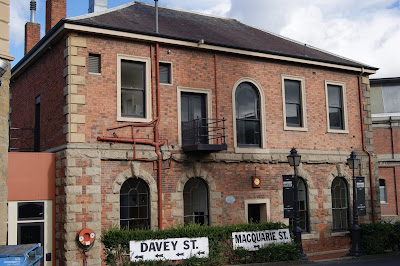The Hobart Gas Company was established by an Act of
Parliament in 1854 and was empowered to manufacture and distribute coal gas and
to establish a gasworks to light the city streets. Technological apparatus and
skilled workers were imported and the gasworks were built off Macquarie Street .
This was the third gasworks in the southern hemisphere, following Sydney (1841)
and Melbourne (1850). The engineer was William Falconer, an experienced Scot
who later built gasworks in Launceston & Latrobe.
The first gas flowed
through the system on 7 March 1857. Coal was also imported, the early fuel
containing a mixture of English Boghead coal. Other coal came mainly from Newcastle in New
South Wales .
For many years, the company’s waste products also
contributed to the local economy, its coke stoking the boilers of many
industries and institutions. Its waste tar was used extensively for road making
and, later, as fuel. At one stage the company manufactured sulphate of ammonia
until this was taken over by the Electrolytic Zinc Co.
As the demand for
gas grew, the gasworks were extended, and in 1894 the Company established an
electric power station to generate and supply electricity to customers
in Hobart and
it installed a series of generators, using gas engines in 1898 and steam from
1901. The chimney and remaining group of buildings housed the generating plant
and offices of the company. With the financial collapse of the private electrical
company, the Gas Co. bought the Hobart
distribution system of that company in 1913. The combined distribution systems
were bought by the new Government Hydro-Electric Department in 1915, after the
Department completed the Waddamana development in 1916 which was Hydro Tasmania's first hydro power station.
In 1924, extra land along Evans Street was
purchased and a reconstruction of the entire site was completed. The purifiers
were relocated, a tank was constructed for tar and liquor, and a new vertical
retort house was constructed. Coal arrived in railway trucks on elevated tracks
and was automatically fed into bunkers on top of the retorts.
Succeeding years saw
problems of economic depression, shortages of coal, and customers' preference
for electricity and despite the
introduction of a catalytic oil system in 1965 to reduce dependence on coal,
the company's fortunes continued to decline. Town gas ended in 1978. Many
of the buildings and all of the equipment were removed to allow Davey Street to be
extended through the site in 1987.
Much
of the industrial heritage was demolished, but the engine house and office
buildings are the remaining buildings that sit in a small rectangular
plot of land, renamed the Gas
Works Village






